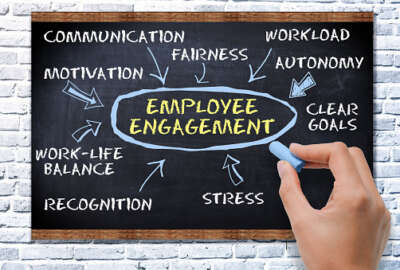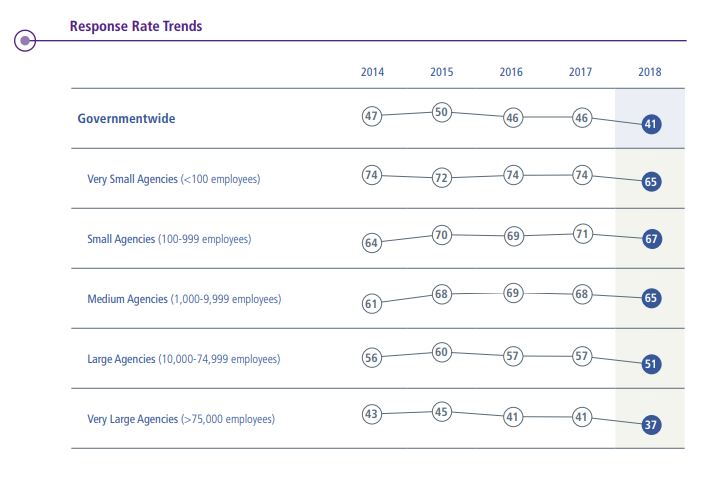

The 2018 Federal Employee Viewpoint Survey is chock-full of data on the federal workforce. Here are four takeaways to consider from this year's survey.
The Trump administration sees the federal workforce as ripe for modernization, and the 2018 Federal Employee Viewpoint Survey offers a treasure trove of data that will likely inform, at least in part, planned changes to the civil service.
The report from the Office of Personnel Management is long, and individual agencies have even more data to parse through and evaluate.
A quick look at the 2018 FEVS offers a few highlights: employee engagement is up again. The Health and Human Services Department and NASA are top-ranking agencies.
But a deeper dive into this year’s results offers at least a few other takeaways. Here are four observations from the 2018 survey.
Where federal employees are happy, they’re really happy.
About 96 percent of employees said they’re willing to put in extra effort to get a job done. And 90 percent believe the work they do is important.
“I have never worked for a private sector company where we could even remotely approach that number,” OPM acting Director Margaret Weichert said Thursday morning at the SAS Leadership Summit in Washington. Weichert actually cited the 2017 number of 91 percent in her comments about employees’ satisfaction with their mission-driven work.
That 90 percent figure is even higher at some agencies.
At the Environmental Protection Agency, for example, 98 percent of employees said they believe the work they do is important.
But compare those responses with those on the lowest scoring questions on the 2018 survey.
Just more than a quarter of federal employees said their pay raises depend on how well they perform. Roughly 32 percent of the workforce believes their agencies take steps to deal with a poor performer.
The responses to these questions are up slightly over the previous year, but they’ve gotten the attention of administration officials like Weichert and may fuel the administration’s initiatives on pay-for-performance or new accountability measures.
Weichert encouraged agency leaders and managers to seek out the trends in the 2018 survey.
“Look at areas where we’re doing well overall, in ratings that are in the 60s, 70s and 80 percent,”
she said in an Oct. 25 video on the survey results. “That’s saying that our workforce believes we’re doing well. I’d particularly focus on any areas in the survey where our employees think we’re not doing well, particularly if we’re in the 20s, 30s or 40s. This suggests our workforce doesn’t have the tools they need or don’t believe that there are structural vehicles in place to help them do the job that the American people want them to be doing.”
Some agencies certainly improved engagement over the previous year, but there were fewer meteoric rises in engagement in 2018.
Engagement at the Homeland Security Department, which declined for six straight years before improving by 4 percent in 2017, remained unchanged at 60 percent in 2018.
DHS subcomponents saw more significant improvements. The Secret Service, which has traditionally been ranked at or near the bottom for the department, improved by 6 percent, the most of any other component, DHS acting Deputy Secretary Claire Grady said in a statement.
The Transportation Security Administration improved by 3 percent, while the Federal Emergency Management Agency boosted its score by 2 percent.
The largest engagement score improvement for six medium, large and very large agencies clocked in at 2 percent. Last year, seven agencies improved engagement by four points.
Organizations like the Partnership for Public Service and even agencies themselves have said boosting participation in the survey should be a best practice in achieving higher employee engagement.
HHS appears to have taken that message to heart. It scored the highest among agencies of its size, achieving a 73 percent engagement score in 2018. It also had the largest participation rate among very large organizations; 57 percent of HHS employees took this year’s survey.
The Energy Department also improved engagement the most among agencies of its size this year and had the highest response rate of 69 percent.
OPM expanded the 2018 FEVS to all permanent, non-seasonal employees this year, meaning the survey was considered a census, rather than a sample. Just more than 598,000 people answered the 2018 survey, for a response rate of 41 percent.
As a sample, the previous year’s survey generated fewer responses — roughly 485,000 — but earned a higher response rate of 46 percent. Only about 100,000 more people took the 2018 survey with the participation pool expanded to most of the federal workforce.
Weichert described 2018’s response rate as “not good enough.”
“It’s particularly important at a time of change, like the one we’re driving with the President’s Management Agenda, that we do get the feedback from the employees and then demonstrate how that is a continuous, positive feedback loop and drives action,” she said. “That’s something that we’ll be working on through focus groups, through using technology to create interactive vehicles for employees to not only see what we’re doing with the survey results, but have them provide continuous feedback.”
The governmentwide response rate on the FEVS has been trending downward since 2015.

Notably, the majority of respondents to the 2018 FEVS — 61 percent — are employees who work in the field as opposed to their agency’s headquarters.
It should also be noted that the Veterans Affairs Department, whose workforce accounts for one-fifth of the entire federal employee population wasn’t included in OPM’s governmentwide engagement report. VA embedded select questions from FEVS into its own all-employee survey this year.
About 25 percent of the federal workforce is planning to retire within five years, according to the 2018 FEVS responses.
Ten percent of respondents said they plan to retire within one-to-three years, while 11 percent said they’re eyeing retirement within three-to-five years. Four percent, or 21,237 respondents, said they’re looking to retire within one year.

This data is notable considering OPM estimates nearly 30 percent of federal employees will be eligible to retire within the next five years.
Meanwhile, 18 percent of employees said they’re planning to take another job within the federal government in the next year, while 9 percent said they were planning to leave for another job entirely or other reasons.
About 67 percent of employees said they had no plans to leave their current positions, according to the 2018 survey.
Copyright © 2024 Federal News Network. All rights reserved. This website is not intended for users located within the European Economic Area.
Nicole Ogrysko is a reporter for Federal News Network focusing on the federal workforce and federal pay and benefits.
Follow @nogryskoWFED

